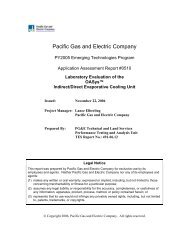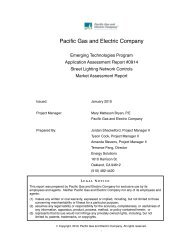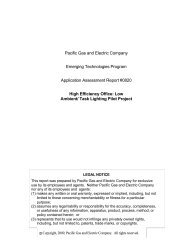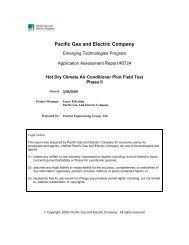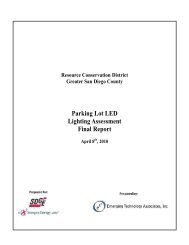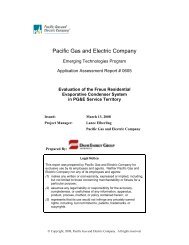Download the project report.
Download the project report.
Download the project report.
You also want an ePaper? Increase the reach of your titles
YUMPU automatically turns print PDFs into web optimized ePapers that Google loves.
For both of <strong>the</strong> HPWHs, <strong>the</strong>ir recovery rates were insufficient to return <strong>the</strong> tanks to <strong>the</strong>ir cut-out<br />
temperatures at <strong>the</strong> end of an hour. Thus, <strong>the</strong> second draws were all done to <strong>the</strong> shut-off temperature<br />
from <strong>the</strong> first draw, and <strong>the</strong> systems were actively heating throughout <strong>the</strong> second draw.<br />
For <strong>the</strong> AirTap unit in <strong>the</strong> heat pump only mode, <strong>the</strong> system was unable to recover enough heat in <strong>the</strong><br />
tank to produce an outlet temperature in excess of <strong>the</strong> termination temperature for <strong>the</strong> first draw. This<br />
means that its first hour rating is only <strong>the</strong> amount taken in <strong>the</strong> first draw. As described in <strong>the</strong> test<br />
procedure, <strong>the</strong> second draw at <strong>the</strong> one-hour mark was only 30-seconds to see what temperature was<br />
available. For <strong>the</strong> first draw, <strong>the</strong> maximum outlet temperature recorded was 132.5°F resulting in a shutoff<br />
temperature mark of 107.5°F. The maximum outlet temperature observed from <strong>the</strong> second draw was<br />
only 100.5°F before it began to fall off again, so none of this second draw was included in <strong>the</strong> rating.<br />
Adding supplemental heat from <strong>the</strong> upper resistance element did allow <strong>the</strong> tank temperature to recover<br />
enough to provide additional hot water to <strong>the</strong> rating for <strong>the</strong> “Normal” mode. It is also notable in Figure 8<br />
how quickly <strong>the</strong> two highest tank <strong>the</strong>rmocouples reacted to <strong>the</strong> operation of <strong>the</strong> upper heating element.<br />
The Rheem was thought to have been tested in two modes of operation, but <strong>the</strong> power usage trend for <strong>the</strong><br />
Energy Saver mode test suggests o<strong>the</strong>rwise as both <strong>the</strong> heat pump and resistance elements were allowed<br />
to operate toge<strong>the</strong>r. In <strong>the</strong> two tests in Energy Saver mode (it was repeated to confirm <strong>the</strong> result from <strong>the</strong><br />
first), <strong>the</strong> unit did not switch on <strong>the</strong> resistive elements as soon as it did in <strong>the</strong> Normal mode test, so <strong>the</strong><br />
test unit may have switched to Normal mode as an override following an especially large draw of hot<br />
water. However, since <strong>the</strong> manufacturer <strong>report</strong>s separate ratings for each mode, this seems unlikely that<br />
this is by design, unless <strong>the</strong> resistance element was locked out in achieving <strong>the</strong>ir rating. All three of <strong>the</strong><br />
test results are close to <strong>the</strong> manufacturer’s listing for <strong>the</strong>ir Energy Saver mode.<br />
Energy Factor<br />
The simplest interpretation of <strong>the</strong> Energy Factor is <strong>the</strong> daily hot water energy output divided by <strong>the</strong> total<br />
energy consumed (with <strong>the</strong> electrical consumption converted to a Btu equivalent by multiplying <strong>the</strong> kWh<br />
by 3,412). The rating is based on a specific volume of hot water removed at a set temperature rise. The<br />
DOE and ASHRAE testing standards include alternative procedures to correct <strong>the</strong> measured test results to<br />
<strong>the</strong> standard volume and temperature conditions, and to compensate for changes in <strong>the</strong> stored energy (as<br />
<strong>the</strong> result of <strong>the</strong> average storage tank temperature being different at <strong>the</strong> beginning and end of <strong>the</strong> 24-hour<br />
period). Both <strong>the</strong> measured values adjusted by <strong>the</strong> two standard methods are included in Table 6 below,<br />
along with a simple calculation method. The “Simple” Energy Factor values use just <strong>the</strong> sum of <strong>the</strong> hot<br />
water energy removed and <strong>the</strong> increase in stored <strong>the</strong>rmal energy divided by <strong>the</strong> electric energy input.<br />
In many cases, <strong>the</strong> Energy Factor test for a particular mode of operation was repeated to confirm an<br />
earlier result or when some parameter was changed. The columns marked EF#1 through #4 are <strong>the</strong><br />
number of tests run in each mode beginning with <strong>the</strong> earliest test run. The one major change was with <strong>the</strong><br />
Rheem system where <strong>the</strong> <strong>the</strong>rmostat was adjusted down, and <strong>the</strong> results are reflected in <strong>the</strong> EF tests #3<br />
and #4 for <strong>the</strong> Energy Saver mode tests. The final test in this group (CR Profile) was one done following<br />
a draw pattern developed by Consumer Reports ® for a water heater test program (Reference 5), and used<br />
to represent a more real-world profile. This test should actually produce higher numbers than <strong>the</strong><br />
standard Energy Factor test because <strong>the</strong> total volume was higher (77 gallons versus 64.3), so <strong>the</strong> tank<br />
standby losses have a lower impact. Only one test was done at this profile, with <strong>the</strong> systems set to <strong>the</strong>ir<br />
Normal operating mode with electrical resistance heat backup. How often <strong>the</strong> resistance heat is activated<br />
has a large effect on <strong>the</strong> daily Energy Factor.<br />
491-09.17.doc 16



